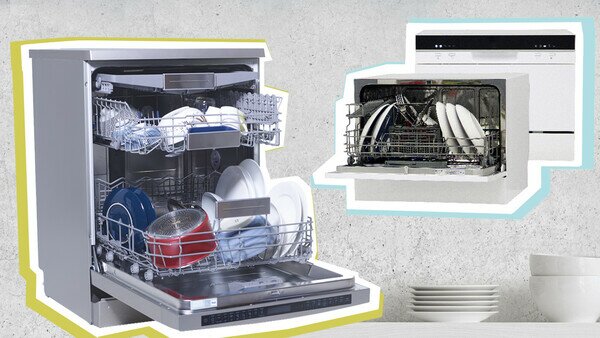Although cooking could help relieve stress for some, washing piles of dirty dishes could be tedious and time-consuming. Unfortunately, Hong Kong’s living environment is too small for a floor-mounted dishwasher and therefore hard for such appliance to gain its popularity. Smaller countertop versions launched in recent years have begun to find favour with local consumers. In a test of 25 models of dishwashers, the Consumer Council found a wide variation among the models in both cleaning and drying performance.
The test, a joint collaboration between the Council and its counterparts in various regions, coordinated by International Consumer Research and Testing (ICRT), included 25 models, comprising 6 small countertop models and 19 large floor standing type with free-standing or built-in models, priced from $2,180 to $22,800. The test focused on cleaning and drying performance, cleaning duration, energy and water efficiency, noise performance, convenience of use, and manufacturing quality.
3 of the 6 countertop models did not require installation, and 1 model had to be assembled with a simple water inlet and drain pipe. Despite distinct advantages in space-saving and ease of installation, their overall performance was judged at best to be ordinary, particularly in cleaning, drying and noise performance. 5 of the 6 models received 3.5 points, while the remaining 1, which was at the top of the group’s price scale ($4,580), had the lowest score of only 2.5 points.
The 19 floor standing models comprised 10 free-standing and 9 built-in types. The test showed wide variation in their cleaning and drying performance as well as cleaning duration, which generally had no direct correlation with the price. In fact, the highest-priced model ($22,800) received an overall rating of only 3.5 and its performance in several test categories is very similar to a $6,880 model scored the same rating. Consumers should bear in mind that all floor-standing models require the installation of a water inlet and drain pipe, and a separate electric socket. Before buying the dishwasher, consumers should arrange an onsite inspection to assess the feasibility and the cost of installation to avoid running over-budget.
In the cleaning test, following International Standard IEC60436, the models were put through 2 separate wash modes: a main mode and an eco mode. The findings showed that the least-performing countertop model scored only 1.5 points and the rest from 3 to 4 points. The free-standing models varied widely from 2.5 to 4.5 points. On the whole, the eco mode uses less water, lower temperature, and longer washing period but it is relatively less effective in cleaning performance than using the main mode.
Regarding drying performance, nearly 70% (4 models) of the countertop models were rated only 1 to 1.5 points as water droplets were found after the drying cycle.
In terms of water consumption, the countertop models used between 4.5 and 9.7 litres, and because of their shorter wash duration, all 6 models scored the full 5 points. By comparison, the free-standing models used considerably more water – from 10.8 to 16.2 litres in the main mode, and from 8.2 to 12.4 litres in the eco mode.
For the time taken to complete the wash cycle, since the countertop types wash fewer dishes, their speed was comparatively faster. 4 of the countertop models completed the main mode in at most 56 to 71 minutes and the eco mode in 101 to 131 minutes. For the free-standing types, the duration for the main and the eco modes was 92 to 197 min (or about 1.5 to 3.3 hrs), and 152 to 238 min (or about 2.5 to 4 hrs), respectively.
In Hong Kong, dishwashers are not covered in the Electrical and Mechanical Services Department’s Energy Efficiency Labelling Scheme. But consumers can access this information on the product website or promotional leaflets to help them choose suitable models with higher energy efficiency.
As for whether washing the dishes by hand or by a dishwasher is more environmentally friendly, past studies pointed out that hand-wash could consume as much as 35 to 160 litres of water on average since hand washing involved rinsing with running water; while dish-washer used less than 14 litres in general. On energy consumption, the amount of energy required for hand-wash with hot water is generally more than that required for a dishwasher to complete a washing and drying cycle.
When choosing dishwashers, consumers should note the following:
- Choose the dishwasher that has the right size for your household needs. Compact capacity countertop models can contain around 22 pieces or less; larger capacity models can hold more kitchenware in one load but they also take up more counter space;
- For consumers with a larger home, floor-standing models could be considered; while for those live in smaller space, countertop models would be more desirable;
- Installation of a floor-standing model requires electricity and water supplies, as well as supporting facilities such as drain pipe and water inlet; ask for on-site inspection when needed;
- Consumers should also consider the amount and expense on detergents specialised for dishwashers. Although dishwashing tablets are more convenient, they are of relatively high cost as whole tablet is needed when in use, while washing powder allows more flexibility that consumers could adjust the usage according to the instructions.
The Consumer Council reserves all its right (including copyright) in respect of CHOICE magazine and Online CHOICE.



